Watershed Conservation Plan - Destination Erie
Watershed Conservation Plan - Destination Erie
Watershed Conservation Plan - Destination Erie
Create successful ePaper yourself
Turn your PDF publications into a flip-book with our unique Google optimized e-Paper software.
zone, the McFate phase has been identified at the Elk County earthwork sites of Kane (36EL1), Russell City<br />
(36EL2), and McKinley (36EL17), and in upland rockshelters in the Clarion River and Tionesta Creek<br />
drainages (Johnson 1999:7). McFate phase vessels are also present at the Bell (36CD31) and Kalgren<br />
(36CD7) sites in the upper reaches of the West Branch of the Susquehanna River (Johnson 1999:7). Finally,<br />
McFate Incised ceramics appear in the Kiskiminetas Valley along the northeastern margin of Monongahela<br />
territory by ca. A.D. 1475–1500 (Johnson 2001:71; Johnson 1999:9), where the immigrant McFate population<br />
and indigenous Monongahela may have intermixed.<br />
3.2 Historical Overview<br />
3.2.1 Early Euro-American Exploration and Settlement of the Greater Study Area<br />
When initially contacted by French Jesuit missionaries and explorers, the indigenous populations of<br />
present-day northwestern Pennsylvania were dominated by the Five Nations Iroquois. Following the defeat<br />
of the Neutral and <strong>Erie</strong> in the mid-seventeenth century, the Seneca expanded their territory to the west and<br />
exercised control over most, if not all, of the area south of Lake <strong>Erie</strong>. Significant Seneca settlements (e.g.,<br />
Te-Car'-Nohs, Goschgoschink, Cussewago, the Buckaloons, Ganagarah'hare [Venango], and Conewango<br />
[Warren]) were reported by the French on the Allegheny River in western New York and northwestern<br />
Pennsylvania by the end of the seventeenth century.<br />
Eager to establish control of the Great Lakes and the Ohio River watershed, the French sent missionaries,<br />
explorers, and traders into the area after 1669 (Stevens and Kent 1941:1). Louis de Joncaire (1670–1739) was<br />
in the upper Allegheny in 1732 as an emissary to promote French ties with the local tribes. Subsequently, in<br />
reaction to perceived English designs on the Ohio Valley, in 1749 the French dispatched an expedition from<br />
Montreal led by Captain Pierre Joseph Céloron de Blainville to assert French claims of suzerainty over the<br />
region. The Céloron expedition traveled via Lake Ontario, the Niagara portage, Lake <strong>Erie</strong>, Lake Chautauqua,<br />
and Conewango Creek to its confluence with the Allegheny River at present-day Warren, Pennsylvania, and<br />
thence to the Ohio.<br />
It appears that actual European contact with the area south of Lake <strong>Erie</strong> predates this time, however,<br />
because when Céloron arrived in northwestern Pennsylvania in 1749 he found English fur-trading stations<br />
at Buckaloons (at the confluence of Brokenstraw Creek and the Allegheny River) and Venango (present-day<br />
Franklin) (Donehoo 1995:244 [1928]; Stevens and Kent 1941:2). Céloron reproached the Seneca for their<br />
dealings with the English. His warnings apparently had little effect, however, for the English posts were still<br />
at Buckaloons and Venango the following year, and it was reported that English traders "…had stores on ye<br />
Lake <strong>Erie</strong>…and upon the Ohio from Bockaloons [sic], an Indian town near its head to below the Mouth of<br />
the Miami River…" (Stevens and Kent 1941:29).<br />
In the mid-eighteenth century, New France established a series of fortifications and posts at strategic<br />
points in western Pennsylvania in an attempt to establish control over the upper Ohio Valley and to drive out<br />
the English. These fortifications included Fort Presque Isle on Lake <strong>Erie</strong>, Fort Le Boeuf (present-day<br />
Waterford) on French Creek, Fort Machault at Venango (present-day Franklin), and Fort Duquesne at the<br />
confluence of the Allegheny and Monongahela Rivers at present-day Pittsburgh. By 1754, the French<br />
controlled the upper Ohio River valley and northwestern Pennsylvania. From their strategically placed<br />
fortifications, the French and their Native American allies harassed and attacked the English as far east as the<br />
Susquehanna River valley and as far south as the settlements of Maryland, Virginia, and southern<br />
Pennsylvania (Stevens and Kent 1941:88). French domination in the French and Indian War continued until<br />
1758 and the fall of Fort Duquesne to English forces. Burning Fort Duquesne, the French retreated to Forts<br />
Machault, Le Boeuf, and Presque Isle, which in turn were burned in 1759 during the final retreat to Detroit,<br />
thereby leaving northwestern Pennsylvania open to English incursion. Within a year, English expeditions<br />
were sent to rebuild and occupy Fort Presque Isle, Fort Le Boeuf, and Fort Venango (near the former French<br />
Fort Machault).<br />
Although the French were removed, hostilities continued in western Pennsylvania with raiding parties<br />
of Iroquois and their allies harassing the English frontier forts. In 1763, the hostilities culminated in a general<br />
attack known as Pontiac's Uprising. Forts Presque Isle, Le Boeuf, and Venango were burned and Fort Pitt was<br />
under attack until Colonel Bouquet raised the siege. Although the English had regained control of the upper<br />
Ohio Valley by 1764, the outlying forts were never rebuilt by the English.<br />
27





